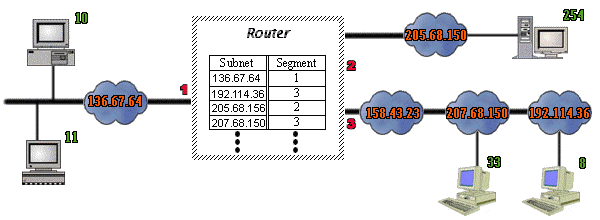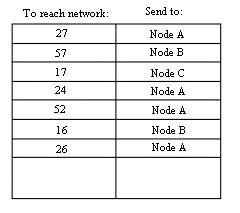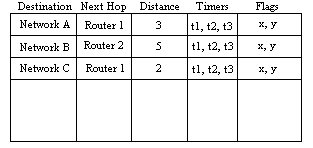|
Introduction
Routing is moving information across
a network from source to destination. Along the way, at least
one intermediate node is typically encountered. Routing is often
contrasted with bridging which seems to accomplish precisely the
same thing. The primary difference between the two is that bridging
occurs at Layer 2 (the link layer) of the OSI reference model,
while routing occurs at Layer 3 (the network layer).
This distinction provides routing and
bridging with different information to use in the process of moving
information from source to destination. As a result, routing and
bridging accomplish their tasks in different ways and, in fact,
there are several different kinds of routing and bridging.
Routing Components
Routing involves two basic activities:
determination of optimal routing paths and the transport of information
groups (typically called packets) through an network.
The latter of these is referred to as switching.
Switching is relatively straightforward. Path determination, on
the other hand, can be very complex.

Figure 1. Network Router
Path Determination
A metric is a number used assigned to
a parameter and is used to quanitfy how "good" or "bad"
that parameter is for a task. For example, path length is used
by routing algorithms to determine the optimal path to a destination.
To aid the process of path determination, routing algorithms initialize
and maintain routing tables, which contain route information.
Route information varies depending on the routing algorithm used.
Routing algorithms fill routing tables
with a variety of information. Destination/next hop associations
tell a router that a particular destination can be gained optimally
by sending the packet to a particular router representing the
"next hop" on the way to the final destination. When a router
receives an incoming packet, it checks the shows an example of
a destination/next hop routing table.

Figure 2. Destination/Next Hop Routing Table
Routing tables can also contain other
information, such as information about the desirability of a path.
Routers compare metrics to determine optimal routes. Metrics differ
depending on the design of the routing algorithm being used. A
variety of common metrics will be introduced and described later
in this chapter.
Routers communicate with one another
(and maintain their routing tables) through the transmission of
a variety of messages. The routing update message is one such
message. Routing updates generally consist of all or a portion
of a routing table. By analyzing routing updates from all routers,
a router can build a detailed picture of network topology. A link-state
advertisement is another example of a message sent between routers.
Link-state advertisements inform other routers of the state of
the sender's links. Link information can also be used to build
a complete picture of network topology. Once the network topology
is understood, routers can determine optimal routes to network
destinations.
Metrics
Routing tables contain information used
by switching software to select the best route. But how, specifically,
are routing tables built? What is the specific nature of the information
they contain? How do routing algorithms determine that one route
is preferable to others?
Routing algorithms
have used many different metrics to determine the best route.
Sophisticated routing algorithms can base route selection on multiple
metrics, combining them in a single (hybrid) metric. All of the
following metrics have been used:
-
Path Length
-
Reliability
-
Delay
-
Bandwidth
-
Load
-
Communication Cost
Path Length
Path length is the most common routing
metric. Some routing protocols allow network administrators to
assign arbitrary costs to each network link. In this case, path
length is the sum of the costs associated with each link traversed.
Other routing protocols define hop count, a metric that specifies
the number of passes through networking products (such as routers)
that a packet must take en route from a source to a destination.
Reliability
Reliability, in the context of routing
algorithms, refers to the reliability (usually described in terms
of the bit-error rate) of each network link. Some network links
may go down more often than others. Once down, some network links
may be repaired more easily or more quickly than other links.
Any reliability factors can be taken into account in the assignment
of reliability ratings. Reliability ratings are usually assigned
to network links by network administrators. They are typically
arbitrary numeric values.
Delay
Routing delay refers to the length of
time required to move a packet from source to destination through
the network. Delay depends on many factors, including the bandwidth
of intermediate network links, the port queues at each router
along the way, network congestion on all intermediate network
links, and the physical distance to be traveled. Because it is
a conglomeration of several important variables, delay is a common
and useful metric.
Bandwidth
Bandwidth refers to the available traffic
capacity of a link. All other things being equal, a 10-Mbps Ethernet
link would be preferable to a 64-kbps leased line. Although bandwidth
is a rating of the maximum attainable throughput on a link, routes
through links with greater bandwidth do not necessarily provide
better routes than routes through slower links. If, for example,
a faster link is much busier, the actual time required to send
a packet to the destination may be greater through the fast link.
Load
Load refers to the degree to which a
network resource (such as a router) is busy. Load can be calculated
in a variety of ways, including CPU utilization and packets processed
per second. Monitoring these parameters on a continual basis can
itself be resource intensive.
Communication Cost
Communication cost is another important
metric. Some companies may not care about performance as much
as they care about operating expenditures. Even though line delay
might be longer, they will send packets over their own lines rather
than through public lines that will cost money for usage time.
Routing Protocols
Routing protocols are broken into the
Exterior Routing protocols which are used in the main part of
the Internet and the Interior Routing protocols used within a
trusted environment. Each of these categories has several different
types of technologies.
Static Routing
Usually an experienced network administrator
will seek to minimize any manual configuration. In the case of
Exterior routing, this may be different, as static routing offers
a number of advantages when routing between Autonomous Systems.
These advantages can be summarized as follows:
-
Complete flexibility over the advertisement of
subnet's and their next hop routers
-
No routing protocol traffic travels over the
link connecting Autonomous Systems
-
As no routing protocol is operating over the
inter-AS link, there is no possibility of a faulty router
in one AS affecting the other AS.
Exterior Routing Protocols
Exterior Gateway Protocol - EGP
As its name suggests, the Exterior Gateway
Protocol, or EGP, was the first example of an exterior gateway
protocol. EGP has three components, Neighbor acquisition, Neighbor
reachability and routing information. EGP was designed to add
a measure of automation to the configuration of routes between
different Autonomous Systems.
The routing information of EGP is similar
to distance vector protocols, but it omits the metric for routes
advertised. EGP was implemented like this because it was designed
for the Internet, when it was assumed that there would be a core
network, with separate routing domains connected to this core
by one router. The major problem with using EGP in a more generalized
network is that, since no use is made of metrics, if there is
more than one path to a destination, packets can very easily get
caught in routing loops.
EGP has been superseded by the Border
Gateway Protocol, BGP.
Border Gateway Protocol - BGP
The main features of BGP are that it
introduced a reliable transport protocol, to ensure that route
updates are received. BGP also implements a keep-alive mechanism,
ensuring that BGP routers know if neighboring BGP routers fail.
BGP does not transmit metrics with it's route updates, but does
transmit a path for each AS that lists the AS's to be visited
on the way to the destination AS. BGP thus avoids the circulating
packet problem of EGP.
BGP works on the principle of enforcing
policies. A policy is manually configured and allows a BGP enabled
router to rank possible routes to other Autonomous Systems, selecting
the best path.
Interior Routing Protocols
Open Shortest Path First - OSPF
Open Shortest Path First (OSPF) is a
routing protocol. As such, it calls for the sending of link state
advertisements (LSAs) to all other routers within the same hierarchical
area. Information on attached interfaces, metrics used, and other
variables are included in OSPF LSAs. As OSPF routers accumulate
link state information, they use the SPF algorithm to calculate
the shortest path to each node.
As a link state routing protocol, OSPF
contrasts with RIP and IGRP, which are distance vector routing
protocols. Routers running the distance vector algorithm send
all or a portion of their routing tables in routing update messages,
but only to their neighbors.
Routing Information Protocol - RIP
The Routing Information Protocol
(RIP) is a routing protocol that keeps tract of routers in its
immediate network and is a very fast routing protocol and useful
for small networks.
Each entry in a RIP routing table provides
a variety of information, including the ultimate destination,
the next hop on the way to that destination, and a metric.
The metric indicates the distance in number of hops to the destination.
Other information can also be present in the routing table, including
various timers associated with the route. A typical RIP routing
table is shown in Figure 3.

Figure 3. Typical RIP Routing Table
RIP maintains only the best route to
a destination. When new information provides a better route, this
information replaces old route information. Network topology changes
can provoke changes to routes, causing, for example, a new route
to become the best route to a particular destination.
When network topology changes occur,
they are reflected in routing update messages. For example, when
a router detects a link failure or a router failure, it recalculates
its routes and sends routing update messages. Each router receiving
a routing update message that includes a change updates its tables
and propagates the change.
Interior Gateway Routing Protocol
and Enhanced IGRP
The Interior Gateway Routing Protocol
(IGRP) is a robust routing protocol and may have an arbitrarily
complex topology consisting of media with diverse bandwidth and
delay characteristics. IGRP uses distance vector routing and has
each router send all or a portion of its routing table in a routing
update message at regular intervals to each of its neighboring
routers. As routing information proliferates through the network,
routers can calculate distances to all nodes within the network.
Distance vector routing protocols are
often contrasted with link state routing protocols, which send
local connection information to all nodes in the network.
IGRP uses a combination (vector) of metrics.
Network delay, bandwidth, reliability, and are all factored into
the routing decision. Network administrators can set the weighting
factors for each of these metrics. IGRP uses either the administrator-set
or the default weightings to automatically calculate optimal routes.
IGRP provides a wide range for its metrics.
For example, reliability and load can take on any value between
1 and 255; bandwidth can take on values reflecting speeds from
1,200 bps to 10 gigabits per second; while delay can take on any
value from 1 to 2 to the 24th power. Wide metric ranges
allow satisfactory metric setting in networks with widely varying
performance characteristics. Most importantly, the metric components
are combined in a user-definable algorithm. As a result, network
administrators can influence route selection in an intuitive fashion.
In Summary:
-
Routers use Layer 3 (IP) to determine how to
route a packet
-
The routing algorithms used outside of a secure
environment are Exterior Gateway Routing Protocols
-
Routers try to determine the optimum path based
on a variety of metrics
-
Addresses may be dynamic (temporary) or static
(permanent)
|

